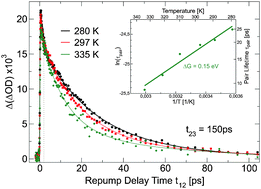Femtosecond electron detachment of aqueous bromide studied by two and three pulse spectroscopy
Abstract
The photodetachment of aqueous bromide after excitation at 202 nm is studied by pump–probe and pump–repump–probe

* Corresponding authors
a
Physik-Department E 11, Technische Universität München, D-85748 Garching, Germany
E-mail:
Hristo.Iglev@ph.tum.de
Fax: +(49) 89 289 12842
The photodetachment of aqueous bromide after excitation at 202 nm is studied by pump–probe and pump–repump–probe

 Please wait while we load your content...
Something went wrong. Try again?
Please wait while we load your content...
Something went wrong. Try again?
M. K. Fischer, A. Laubereau and H. Iglev, Phys. Chem. Chem. Phys., 2009, 11, 10939 DOI: 10.1039/B913688F
To request permission to reproduce material from this article, please go to the Copyright Clearance Center request page.
If you are an author contributing to an RSC publication, you do not need to request permission provided correct acknowledgement is given.
If you are the author of this article, you do not need to request permission to reproduce figures and diagrams provided correct acknowledgement is given. If you want to reproduce the whole article in a third-party publication (excluding your thesis/dissertation for which permission is not required) please go to the Copyright Clearance Center request page.
Read more about how to correctly acknowledge RSC content.
 Fetching data from CrossRef.
Fetching data from CrossRef.
This may take some time to load.
Loading related content
